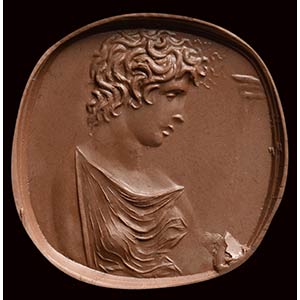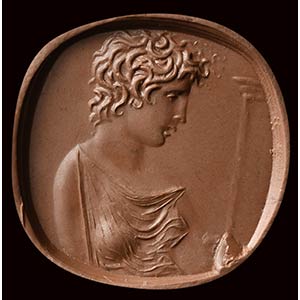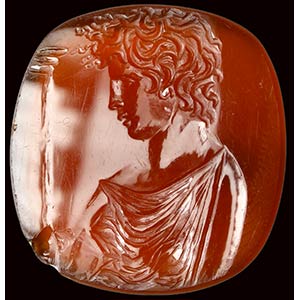
- Startseite
- Aktive Auktionen
-
Beendete Auktionen
- Münzen und Medaillen
- Philatelie
- Antiquities
- Alte Meister
- Juwelen, Silber und Uhren
- Alte und Moderne Glittica
- Alte Porzellane und Keramik
- Antiques
- Moderne und zeitgenössische Kunst
- 20. Jh. Design und Dekorative Kunst
- Drucke und Multiples
- Asiatische und tribal Kunst
- Fotografie
- Mittelalterliche Kunst
- Alte Rahmen
- Mode und Textilkunst
- Bücher, Autogramme und Erinnerungsstücke
- Wines and spirits
- Oddities, Curiosities & Wonders
- Info
- Live Bidding
- Startseite
- Auction 86
- 184 A very fine and large greek late hellenistic carnelian ...
Los Nr. 184 - Auction 86
Beschreibung
2nd-1st century B.C.
21 x 21 x 4 mm
The young character is facing left, with the head in profile slightly inclined downwards. The bust is instead depicted in three quarters, with uncovered shoulders and the chest characterized by a delicate breast, covered only by a light, very tight tunic. The character is characterized by thick hair, formed by elegant curvilinear locks that cover the head descending on the nape and forehead, rising slightly at the top. The anatomical volumes of the face and torso are executed with a very low and delicate relief, while the hair and the tunic, almost a wet drapery that sensually reveals the underlying breast, are engraved with more marked and raised lines. In front of the figure, always in very low relief, almost imperceptible, we can see a structure, probably architectural, with a frame (rather than considering it a scepter?). The identification of the character is not clear and multiple, given the absence of safe attributes. The iconography and composition of the scene recall for some details a gem from the Farnese collection, depicting a female bust characterized by the same half-closed mouth and very short hair with wavy, almost masculine locks, in the act of contemplating a mask and identified as Melpomene. Musa is in fact defined as the character depicted half-length with a chiton, in front of a column / architectural structure with a frame on top of a mask, exactly in front of his face framed equally by a wavy and very short hair (Dactyliotheca Capponiana). This iconography is in fact considered as the representation of poetry or of a poet. The ephebic face, young and very delicate, has almost masculine features, similar to the androgynous beauty of Antinous. The small eye, the linear nose, the small fleshy and slightly open mouth, the rounded chin, the hair disordered by curvilinear locks that dominate the head, the delicate and engraved bust with imperceptible relief compared to the dress, the attitude of the face and his languid contemplative expression: all stylistic details referable to the late Greek production of the Hellensitic period, full of pathos and characterized by an extreme and extraordinary executive refinement. In the valuable catalog raisonné concerning the Greek portraits in the Cabinet des Médailles in Paris, the impression of a gem (n. 111) considered as lost and of unknown location, certainly from the De Clecq collection, was taken from a Ptolemaic gem. This piece depicts the portrait of a young princess daughter of Ptolemy VI and Cleopatra II, dressed only in an almost transparent peplum delicately fixed on the bare shoulders; in front of her a spike and a poppy flower: The face, also in this case, is characterized by a sweet melancholy, full of pathos and delicacy, the features of the flight refined, in very low relief, the mouth slight opened, the head in profile slightly inclined downwards, the nose straight ahead. Its physical and stylistic characteristics, the compositional and executive typology are very similar and in part identical to the carnelian bust carving yet to be identified. Apparently both can be traced back to the same cultural and artistic sphere, perhaps to the same engraving workshop. The carnelian intaglio can probably depicts in the same way a prolemaic princess of the Seleucid empir. The gem is masterfully engraved with great art and technical expertise; the stone, chracterized by a pure deep red, is mirror polished. Chip on the edge. Artwork of great rarity.
Parallels: M. L. Vollenweider, Camées et intailles, Tome I, Les Portraits grecs du Cabinet des médailles, n. 111, 123, 124, 209, 217; Le Gemme Farnese, 1994, p. 126 n. 192 (296); M. L. Ubaldelli, Dactyliotheca Capponiana, p. 224.
U.K., private collection 70's, in the same family since then.
Bitte melden Sie sich an, oder registrieren Sie sich für Ihren persönlichen Zugang.
Für weitere Informationen schreiben Sie uns an info@bertolamifineart.com
 Cookie-Richtlinie
Cookie-Richtlinie
Diese Website verwendet Cookies , um die Benutzererfahrung zu verbessern und Informationen über die Nutzung der Website zu sammeln. Es gibt auch Cookies, die für die Auswahl personalisierter Anzeigen und Werbeinhalte verwendet werden können. Sie können unsere Cookie-Richtlinie lesen, alle Cookies akzeptieren und fortfahren durch Klicken auf "Akzeptieren" oder Ihre Auswahl anpassen, indem Sie auf "Anpassen" klicken.
Cookie-Richtlinie
Cookies
Damit diese Website ordnungsgemäß funktioniert, installieren wir manchmal kleine Dateien namens " Cookies " auf Ihrem Gerät. Die meisten großen Websites tun dasselbe.
Was sind Cookies?
Ein Cookie ist eine kleine Textdatei, die Websites auf Ihrem Computer oder Mobilgerät speichern, während Sie sie besuchen. Dank Cookies merkt sich die Site Ihre Aktionen und Präferenzen (z. B. Login, Sprache, Schriftgröße und andere Anzeigeeinstellungen), sodass Sie diese nicht erneut eingeben müssen, wenn Sie zur Site zurückkehren oder von einer Seite zur anderen navigieren.
Wie verwenden wir Cookies?
Cookies von Drittanbietern
Google Analytics
Diese Website verwendet Google Analytics, um Informationen über die Nutzung der Website durch die Nutzer zu sammeln. Google Analytics generiert statistische und andere Informationen durch Cookies, die auf den Computern der Benutzer gespeichert werden. Die über unsere Website erzeugten Informationen werden verwendet, um Berichte über die Nutzung von Websites zu erstellen. Diese Informationen werden von Google gespeichert und verwendet. Die Datenschutzerklärung von Google ist unter folgender Adresse abrufbar: https://policies.google.com/privacy .
Es ist nicht erforderlich, Cookies zu aktivieren, damit die Website funktioniert, aber dies verbessert die Navigation. Es ist möglich, Cookies zu löschen oder zu blockieren, aber in diesem Fall können einige Funktionen der Website nicht richtig funktionieren.Die Informationen zu Cookies werden nicht verwendet, um Benutzer zu identifizieren, und die Navigationsdaten stehen immer unter unserer Kontrolle. Diese Cookies werden ausschließlich für die hier beschriebenen Zwecke verwendet.
So kontrollieren und ändern Sie Cookies?
Sie können Ihre Einwilligung jederzeit in der Cookie-Erklärung ändern oder widerrufen unsere Website.
Datenschutzerklärung
Erfahren Sie mehr darüber, wer wir sind, wie Sie uns kontaktieren können und wie wir personenbezogene Daten verarbeiten in unserer Datenschutzrichtlinie .
Die notwendigen Cookies helfen dabei, die Website nutzbar zu machen, indem sie grundlegende Funktionen wie Seitennavigation und Zugriff auf geschützte Bereiche der Website ermöglichen. Ohne diese Cookies kann die Website nicht richtig funktionieren.
| Name | Lieferant | Zweck | Ablauf |
|---|---|---|---|
| cookieConsent | bidinside | Speichert den Cookie-Zustimmungsstatus des Benutzers für die aktuelle Domäne | 6 Monate |
| PHPSESSID | bidinside | Bewahren Sie den Status des Benutzers auf den verschiedenen Seiten der Site auf. | Wenn die Browsersitzung endet |
| f_display | bidinside | Die f_display-Cookies speichern den vom Benutzer gewählten Anzeigemodus auf den Seiten mit Listen | Wenn die Browsersitzung endet |
| f_page | bidinside | Die f_page-Cookies speichern die vom Benutzer angezeigte Seite auf den Seiten, auf denen Listen vorhanden sind | Wenn die Browsersitzung endet |
| f_rec_page | bidinside | Die f_rec_page-Cookies speichern die Anzahl der Elemente, die pro vom Benutzer ausgewählter Seite auf den Seiten angezeigt werden sollen, auf denen Listen vorhanden sind | Wenn die Browsersitzung endet |
| f_order_by | bidinside | Die f_order_by-Cookies speichern die vom Benutzer ausgewählten Sortierparameter auf den Seiten, auf denen Listen vorhanden sind | Wenn die Browsersitzung endet |
| f_order_dir | bidinside | Die Cookies f_order_dir speichern die vom Benutzer gewählte Bestellrichtung auf den Seiten, auf denen Listen vorhanden sind | Wenn die Browsersitzung endet |
| watch_list_show_imgs | bidinside | Das Cookie watch_list_show_imgs speichert die Wahl des Benutzers, die Bilder der Lose auf der Merklistenseite anzuzeigen oder auszublenden | Wenn die Browsersitzung endet |
| selected_voice | bidinside | Das Cookie selected_voice speichert die vom Benutzer ausgewählte Stimme für die in der Live-Auktion vorhandene Sprachsynthese | 1 Monat |
| include_autobids | bidinside | Das Cookie include_autobids speichert die Wahl des Benutzers, seine auto-bid auf der Seite 'Ihre Gebote' anzuzeigen oder auszublenden | 6 Monate |
Analytische Cookies helfen zu verstehen, wie Besucher mit der Website interagieren, indem sie statistische Informationen sammeln und an den Datenverantwortlichen übermitteln.
| Name | Lieferant | Zweck | Ablauf |
|---|---|---|---|
| _ga | Registrieren Sie eine eindeutige ID, die verwendet wird, um statistische Daten darüber zu generieren, wie der Besucher die Website nutzt. | 2 Jahre | |
| _gat_gtag | Wird von Google Analytics verwendet, um die Häufigkeit von Anfragen zu begrenzen | 1 Tag | |
| _gat | Wird von Google Analytics verwendet, um die Häufigkeit von Anfragen zu begrenzen | 1 Tag | |
| _gid | Registrieren Sie eine eindeutige ID, die verwendet wird, um statistische Daten darüber zu generieren, wie der Besucher die Website nutzt. | 1 Tag | |
| __utma | bidinside | Wird verwendet, um Benutzer und Sitzungen zu unterscheiden. Das Cookie wird erstellt, wenn die Javascript-Bibliothek ausgeführt wird und keine vorhandenen __utma-Cookies vorhanden sind. Das Cookie wird jedes Mal aktualisiert, wenn Daten an Google Analytics gesendet werden. | 2 jahre |
| __utmt | bidinside | Wird verwendet, um die Anforderungsrate zu drosseln. | 10 minuten |
| __utmb | bidinside | Wird verwendet, um neue Sitzungen/Besuche zu bestimmen. Das Cookie wird erstellt, wenn die Javascript-Bibliothek ausgeführt wird und keine vorhandenen __utmb-Cookies vorhanden sind. Das Cookie wird jedes Mal aktualisiert, wenn Daten an Google Analytics gesendet werden. | 30 minuten |
| __utmc | bidinside | Wird in ga.js nicht verwendet. Auf Interoperabilität mit urchin.js eingestellt. In der Vergangenheit wurde dieses Cookie in Verbindung mit dem __utmb-Cookie verwendet, um festzustellen, ob sich der Benutzer in einer neuen Sitzung/einem neuen Besuch befand. | Wenn die Browsersitzung endet |
| __utmz | bidinside | Speichert die Zugriffsquelle oder Kampagne, die erklärt, wie der Benutzer auf Ihre Website gelangt ist. Das Cookie wird erstellt, wenn die JavaScript-Bibliothek ausgeführt wird, und wird jedes Mal aktualisiert, wenn Daten an Google Analytics gesendet werden. | 6 monate |
| __utmv | bidinside | Wird verwendet, um benutzerdefinierte variable Daten auf Besucherebene zu speichern. Dieses Cookie wird erstellt, wenn ein Entwickler die Methode _setCustomVar mit einer benutzerdefinierten Variablen auf Besucherebene verwendet. Dieses Cookie wurde auch für die veraltete Methode _setVar verwendet. Das Cookie wird jedes Mal aktualisiert, wenn Daten an Google Analytics gesendet werden. | 2 jahre |
Präferenz- / technische Cookies ermöglichen einer Website, sich an Informationen zu erinnern, die das Verhalten oder die Darstellung der Website beeinflussen, wie z. B. Ihre bevorzugte Sprache oder die Region, in der Sie sich befinden.
Wir verwenden keine Cookies dieser Art.Profiling-Cookies werden für Marketingzwecke verwendet, um Website-Besucher zu überwachen. Die Absicht besteht darin, relevante und ansprechende Anzeigen für den einzelnen Benutzer anzuzeigen.
| Name | Lieferant | Zweck | Ablauf |
|---|---|---|---|
| _fbp | Facebook-Pixel, Targeting- und Werbe-Cookie. Dieses Cookie ermöglicht es uns, unsere Werbung Personen zu zeigen, die unsere Website bereits besucht haben, wenn sie auf Facebook oder auf einer von Facebook Advertising unterstützten digitalen Plattform sind. | 6 Monate | |
Nicht klassifizierte Cookies sind Cookies, die zusammen mit einzelnen Cookie-Anbietern klassifiziert werden.
Wir verwenden keine Cookies dieser Art.










 185
185